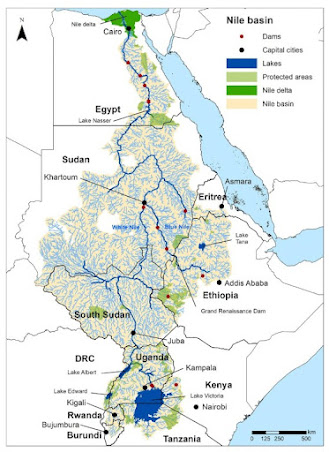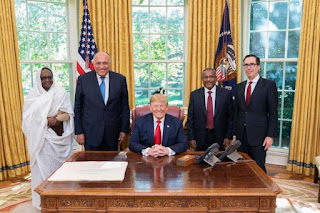The Nile River and the complicated politics of water management
Welcome back!
This post will delve deeper on the source of hope for economic development for certain countries as well as the source of conflict between countries, the Nile River and its basin, taking a closer look at Egypt's position.
The Nile River Basin covers parts of 11 different countries, stretching from Egypt in the North to Tanzania and the DRC in the South, and is a source of water for over 300 million people. The transnational nature of the basin leads to uneven distribution and control of the water. The main users of water in the basin are agriculture and hydropower at about 85%, with almost all irrigation located in Egypt and Sudan (Digna et al, 2017), but not all countries need the water to the same degree or for the same purposes (Milas, 2013).
For example, Egypt, the country furthest downstream, views the Nile River as its sole significant water source and the reliability of its water flow as an extremely important matter (Dadson et al, 2018). Since the main water resources come from outside its territory, Egypt finds itself in a vulnerable position and regards the Nile river as a matter of national security (Amer and Hefny, 2005). The country relies entirely on irrigated agriculture from the Nile for food production, a sector which employs 40% of the Egyptian population, who lives in rural areas (Milas, 2013). Egypt, as a downstream country, is extremely worried that upstream nations might interfere with the Nile's flow, and even obstruct it for their benefit (Arsano, 2007). Egypt is becoming more and more worried as its historical right to the Nile's waters, guaranteed by the 1929 treaty signed with Britain, who had colonised most of the Nile riparian countries, is becoming increasingly contested by the upstream nations. The 1929 Nile Treaty forbids any nation upstream (to the south of Egypt) to diminish the water volume that reaches Egypt and north Sudan (Cocks, 2004). Upstream countries, who view this treaty as a colonial relic, want it to be abrogated as it forbids them to build infrastructures that would allow them to benefit from the Nile river.
How can the Nile river be managed in a way such that every country reliant on it can benefit and use the water without being at the mercy of other countries impacting the volume of water flowing downstream? An attempt at transnational cooperation for the management of the Nile river Basin is the Nile Basin Initiative, established in 1999, a joint endeavour between Nile riparian countries to take advantage of the opportunities and maximise benefits (Jungudo, 2018). The Nile Basin Initiative provides a platform for countries to discuss how to take care and use the shared Nile river collectively.
However, the transboundary cooperation facilitated by the Nile Basin Initiative is not enough to calm the tensions and ease discussion between the riparian countries, and certainly not enough to ease Egypt's worries in the face of a threat to its water security: the Grand Ethiopian Renaissance Dam, which will be the next post's topic.



Comments
Post a Comment